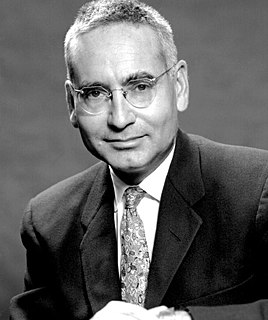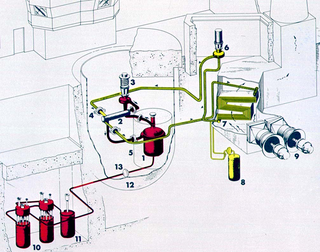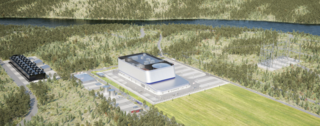The Blue Hills Nuclear Power Plant was a proposed commercial nuclear power plant 20 miles northeast of Jasper, Texas. Coordinates: 31°9′N93°42′W / 31.150°N 93.700°W [1] It was proposed in the 1970s by the Gulf States Utilities Company. One 918 MWe pressurized water reactor was ordered in 1973, and an additional 918 MWe reactor was ordered in 1974 from Combustion Engineering. [2] The two unit power plant proposal was canceled in 1978. [3]

Oak Ridge National Laboratory (ORNL) is a U.S. multiprogram science and technology national laboratory sponsored by the U.S. Department of Energy (DOE) and administered, managed, and operated by UT–Battelle as a federally funded research and development center (FFRDC) under a contract with the DOE, located in Oak Ridge, Tennessee.

A molten salt reactor (MSR) is a class of nuclear fission reactor in which the primary nuclear reactor coolant and/or the fuel is a molten salt mixture. Only two MSRs have ever operated, both research reactors in the United States. The 1950's Aircraft Reactor Experiment was primarily motivated by the compact size that the technique offers, while the 1960's Molten-Salt Reactor Experiment aimed to prove the concept of a nuclear power plant which implements a thorium fuel cycle in a breeder reactor. Increased research into Generation IV reactor designs began to renew interest in the technology, with multiple nations having projects, and as of September 2021, China is on the verge of starting its TMSR-LF1 thorium MSR.

The Aircraft Reactor Experiment (ARE) was an experimental nuclear reactor designed to test the feasibility of fluid-fuel, high-temperature, high-power-density reactors for the propulsion of supersonic aircraft. It operated between November 8-12, 1954 at the Oak Ridge National Laboratory (ORNL) with a maximum sustained power of 2.5 megawatts (MW), and generated a total of 96 MW-hours of energy.
SM-1 was a 2-megawatt nuclear reactor developed by the American Locomotive Company (ALCO) and the United States Atomic Energy Commission (AEC) as part of the US Army Nuclear Power Program (ANPP) in the mid-1950s. The compact "package" reactor was designed to produce electricity and generate heat for remote military facilities. The first, the SM-1, served as the Army's primary training facility to train reactor operations personnel from all three services. In 1954, the Department of Defense placed the US Army in charge of all military nuclear power plants except those used for propulsion by the US Navy. The Army's Chief of Engineers established the US Army Engineer Reactors Group in April 1954, and decided to construct the SM-1 facility at the Corps of Engineers headquarters at Fort Belvoir, Virginia, about 18 miles south of Washington, D.C. About 800 personnel were trained on the SM-1 during its operational life, from 1957 to 1973. The power plant was shut down in March 1973, and is monitored within a "restricted access" section of the post. Inspectors enter the shut-down operations control room every decade or so. The Army plans to start demolition in 2020.

Aqueous homogeneous reactors (AHR) are a type of nuclear reactor in which soluble nuclear salts are dissolved in water. The fuel is mixed with the coolant and the moderator, thus the name "homogeneous". The water can be either heavy water or ordinary (light) water, both of which need to be very pure.

A high-temperature gas-cooled reactor (HTGR), is a nuclear reactor that uses a graphite moderator with a once-through uranium fuel cycle. The HTGR is a type of high-temperature reactor (HTR) that can conceptually have an outlet temperature of 750 °C (1,380 °F). The reactor core can be either a "prismatic block" or a "pebble-bed" core. The high temperatures enable applications such as process heat or hydrogen production via the thermochemical sulfur–iodine cycle.

The Aircraft Nuclear Propulsion (ANP) program and the preceding Nuclear Energy for the Propulsion of Aircraft (NEPA) project worked to develop a nuclear propulsion system for aircraft. The United States Army Air Forces initiated Project NEPA on May 28, 1946. NEPA operated until May 1951, when the project was transferred to the joint Atomic Energy Commission (AEC)/USAF ANP. The USAF pursued two different systems for nuclear-powered jet engines, the Direct Air Cycle concept, which was developed by General Electric, and Indirect Air Cycle, which was assigned to Pratt & Whitney. The program was intended to develop and test the Convair X-6, but was canceled in 1961 before that aircraft was built. The total cost of the program from 1946 to 1961 was about $1 billion.

A generation II reactor is a design classification for a nuclear reactor, and refers to the class of commercial reactors built until the end of the 1990s. Prototypical and older versions of PWR, CANDU, BWR, AGR, RBMK and VVER are among them.

The X-10 Graphite Reactor is a decommissioned nuclear reactor at Oak Ridge National Laboratory in Oak Ridge, Tennessee. Formerly known as the Clinton Pile and X-10 Pile, it was the world's second artificial nuclear reactor, and the first designed and built for continuous operation. It was built during World War II as part of the Manhattan Project.

Alvin Martin Weinberg was an American nuclear physicist who was the administrator at Oak Ridge National Laboratory (ORNL) during and after the Manhattan Project. He came to Oak Ridge, Tennessee, in 1945 and remained there until his death in 2006. He was the first to use the term "Faustian bargain" to describe nuclear energy.

The Molten-Salt Reactor Experiment (MSRE) was an experimental molten salt reactor at the Oak Ridge National Laboratory (ORNL) researching this technology through the 1960s; constructed by 1964, it went critical in 1965 and was operated until 1969. The costs of a cleanup project were estimated at about $130 million.
As of 2017, nuclear power in Pakistan is provided by five commercial nuclear power plants. Pakistan is the first Muslim majority country in the world to construct and operate civil nuclear power plants. The Pakistan Atomic Energy Commission (PAEC), the scientific and nuclear governmental agency, is solely responsible for operating these power plants. As of 2018, the electricity generated by commercial nuclear power plants constitutes roughly 7.5% of electricity generated in Pakistan, Pakistan is not a party to the Nuclear Non-Proliferation Treaty but is a member of the International Atomic Energy Agency. Pakistan plans on constructing 32 nuclear power plants by 2050 and envisions 40,000 MW of nuclear power generation.

The Clinch River Nuclear Site (CRNS) is a project site owned by the Tennessee Valley Authority (TVA). It was once proposed as the Clinch River Breeder Reactor Project of the U.S. Atomic Energy Commission and the U.S. electric power industry to design and construct a sodium-cooled fast-neutron nuclear reactor. The project was opposed by President Carter.
The Alan R. Barton Nuclear Plant was a proposed commercial nuclear power plant in central Alabama, United States.

Juragua Nuclear Power Plant was a nuclear power plant under construction in Cuba when a suspension of construction was announced in 1992 following the collapse of the Soviet Union and the termination of Soviet economic aid to Cuba. Russia and Cuba sought third-country financing to complete the plant in the mid 1990s but in 2000 the two countries agreed to abandon the project.
The Allens Creek Nuclear Power Plant was a proposed nuclear power plant to be located at Wallis, Texas, less than 50 miles from the western edge of Houston. The plant, consisting of two 1,150 MWe General Electric boiling water reactors, was ordered by Houston Lighting and Power Company (HL&P) in 1973, but public opposition, fueled in part by press coverage of problems at other nuclear plants around the country, led to lengthy public hearings and court action. In the meantime, construction costs escalated and the plant was officially canceled in 1982.
The Atlantic Nuclear Power Plant was a proposed floating nuclear power plant located off the coast of New Jersey. It was proposed in the 1970s by the Public Service Electric and Gas Company. Two Westinghouse 1,150 MWe (net) pressurized water reactors were ordered in 1972, and another two Westinghouse 1,150 MWe (net) reactors were ordered in 1973. The four unit power plant proposal was canceled in 1978.
The Greene County Nuclear Power Plant was proposed in 1974 by the Power Authority of the State of New York. A single 1,212 MWe Babcock & Wilcox pressurized water reactor was to be built approximately 5 miles south of Catskill, New York on the western shore of the Hudson River, but the plant proposal was canceled in 1979, largely due to concerns over social and economic disruptions to the local communities.

The Haven Nuclear Power Plant was a proposed nuclear power plant in Haven, Wisconsin north of Sheboygan at the site of closed military camp called Camp Haven. The power plant was proposed in the 1970s by Wisconsin Electric, but was never built. Two 900 MWe Westinghouse pressurized water reactor were proposed in 1973. Reactor one was canceled in 1978 and reactor two was canceled in 1980. After plans never materialized, the Kohler Company purchased the site. Construction of the Whistling Straits golf course began in 1995.